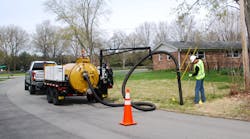Culvert pipe bidding requirements for state highway work were originally described in a special paragraph in the 1974 Code of Federal Regulations. All other construction materials and product requirements were included in an unrelated paragraph of the code. The recently passed SAFETEA-LU (Safe, Accountable, Flexible, Efficient Transportation Act: A Legacy for Users) legislation instructed the Federal Highway Administration (FHWA) to amend the code to say: "States provide for competition with respect to the specification of alternative types of culvert pipes through requirements that are commensurate with competition requirements for other construction materials."
In November 2006, FHWA issued its "rulemaking" on this subject. The new rule eliminated the special paragraph for culvert pipe. The ruling implies that culvert pipe along with all other construction materials and products conform to the same bidding rules. These long-standing rules require that when alternative products are judged to be of satisfactory quality and equally acceptable — on the basis of engineering and economic analysis, alternative-bidding practices must be used.
FHWA's rulemaking does not mandate that every project include all culvert types as bid alternatives. With engineering and LCA (Least Cost (Life Cycle) Analysis) documentation, state DOTs can specify the appropriate pipe for highway drainage systems without appearing biased.
The intent of this article is to offer the engineer some insights when documenting an engineering and economic analysis for highway drainage structures.
The Role Of The EngineerFHWA's ruling does not change the basic role of the design engineer. Engineers should always consider engineering and economic analyses when designing projects. Their role in any design project is to design a project that meets the desired purpose, is constructible, and protects the health, safety and welfare of the user. The engineer should always strive to provide the best value and longevity to the owner.
Before making a final recommendation to the client, the engineer has a responsibility to analyze life cycle costs, the risks associated with the chosen pipe product, and to inform the client about the short-term and long-term costs, as well as any other risks that may be identified during the selection of pipe material. Designers must be cognizant of all aspects and design responsibilities when using any pipe material before specifying that material because materials and their service lives differ greatly.
Engineering AnalysisAn engineer has the legal responsibility to determine that the product being specified shall perform as intended for the specific project in which the design is performed. Before specifying a particular product, the engineer must be aware of the characteristics, applications, potential deficiencies, and limitations of the product.
Differences between pipe materials must be fully understood by the design engineer before selecting the type of culvert pipe. The engineer must review the specified products and their performance expectations for in situ conditions and evaluate available literature to ensure that the proper considerations are being made. The engineer must take care to distinguish manufacturers' claims from facts regarding their product.
Reasonable diligence also requires engineers to have read and understood the most recent ASTM and AASHTO standards to ensure that the structural design considers all aspects of both the standards' requirements, as well as the recommendations of those standards. Some ASTM and AASHTO specifications place significant responsibility upon the engineer regarding installation to ensure service performance. These specifications may require an engineered installation in which the engineer must be involved in the construction activities. The engineer must also take responsibility to ensure that post-installation testing has been performed and documented.
Design of any pipe system requires knowledge of material properties, installation conditions and external loads. All of these elements combine to define the behavior of the installed pipe.
Rigid Versus FlexibleStorm drainage pipe is classified as either "rigid" or "flexible." Reinforced concrete pipe (RCP) is a rigid pipe. Thermoplastic and metal pipe is classified as "flexible." Flexible pipe designs and rigid pipe designs are unique designs that must not be interchanged.
Rigid PipeRigid pipes are independent load-bearing structures. A single length of RCP is designed, built and tested as a structure before it arrives at the construction site. RCP installations may be as much as 85 percent dependent upon the pipe strength with only 15 percent dependent upon the strength derived from the soil envelope. The inherent strength of reinforced concrete pipe generally compensates for many construction and project design shortcomings. RCP maintains its shape by not deflecting, has a range of pipe strengths and installations from which to choose, and its strength is demonstrated prior to installation.
Standard Installations is a method used for designing and installing precast concrete pipe. In many instances, site conditions suitable for concrete pipe are inappropriate for a flexible pipe installation that is reliant on the structure of the surrounding soil. Standard Installations provide versatility to meet design requirements and site conditions. They allow for narrow excavation limits, thereby requiring less expensive backfill materials.
Flexible PipeIndividual flexible pipes are not independent structures. The flexible pipe structure is built and tested in the field. In a flexible pipe installation, the vertical load is transferred to the side support soil and the pipe must deflect to function. Engineers must use the soil to construct an envelope of supporting material around flexible pipe, so that the vertical load is adequately supported. The extent to which the pipe depends on this soil envelope for support is a function of the depth of cover, surface loading and the ring stiffness of the pipe. The soil-pipe interaction provides the necessary long-term support for the pipe. The prime structure in a flexible pipe system is the soil envelope.
Since flexible pipe is soil dependent, the behavior of the soil-pipe system requires a determination of the interaction that will occur between the pipe, embedment material and the native soil. The sum of these components acting together determines the total system behavior. Since the soil in the flexible soil-pipe interaction can account for up to 90 percent of an installation's success, a geotechnical or soils engineer may need to be consulted to verify an engineer's design.
Plastic pipe designs must use separate values for short-term and long-term allowable stress, and yet no test is performed to verify the long-term value. Other factors that affect the service life of plastic pipe include the flammability of polyethylene and UV sensitivity.
The only way to ensure proper installation of a flexible pipe, with the soil envelope fully developed, is to test for excessive deflection. Post installation inspection of flexible pipe should be in every construction specification. Unlike RCP, deflection characteristics are the prime consideration in the structure design of flexible pipe. Flexible pipe is not an equal material alternative to rigid pipe.
Economic AnalysisWhen deciding if alternative bidding practices are to be used on a highway project, the engineer must consider economics. An economic analysis is much more than comparing historical unit bid costs. Often, engineers specify materials for drainage systems based solely on initial (capital) costs. Lower initial costs, however, do not always result in the most economically efficient product or system. To determine the best choice, the principles of economics must be applied through a Least Cost Analysis.
According to the U.S. Army Corps of Engineers, selection of all systems, components and materials for civil works projects are based on their long-term performances, and performance considerations may include LCA. The cost consideration in a project must be based on the long-term performance of the material being used, not only the initial cost. It is crucial that design engineers implement life cycle design concepts into the project development process.
The most widely debated variable in the LCA analysis is material service life. While the FHWA does not address material service life values, the U.S. Army Corps of Engineers specification shows RCP having a service life of 70 to 100 years. Corrugated metal pipe may obtain up to a 50-year service life in most environments with the use of coatings. The corps states that the long-term performance of aluminum pipe is difficult to predict due to a short history of use and the designer should not expect a material service life of greater than 50 years. They also suggest that the designer should not expect a material service life greater than 50 years for any plastic pipe.
Given the differences between rigid and flexible pipe, it is essential that the engineer understand that the design of the two piping systems is vastly different. They cannot be judged as equally acceptable merely because they are both drainage products. Accurate engineering and economic analyses can be accomplished only when the distinction between the products is understood.
A single pipe material with no equal may be the outcome when state DOT engineers analyze the properties and life cycle cost benefits of different pipe materials. In some installation conditions, flexible pipe may be not be appropriate at all.
FHWA's rulemaking, as an outcome of SAFETEA-LU, does not mandate that every project include all culvert types as bid alternatives. With engineering and LCA documentation, state DOTs can justify the most appropriate pipe for highway drainage systems.
| Author Information |
| Mike Beacham is director of government relations, American Concrete Pipe Association. |




